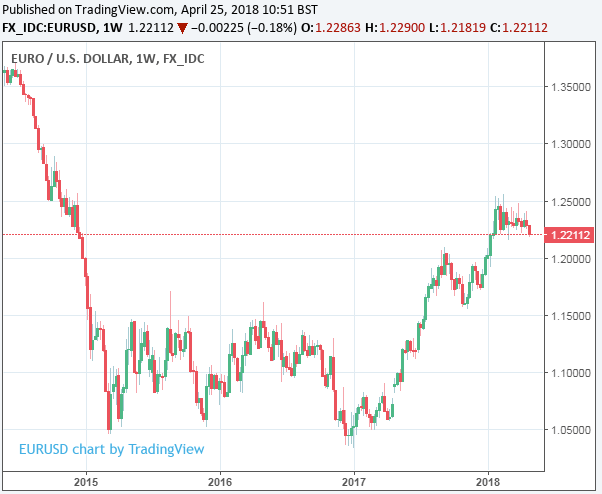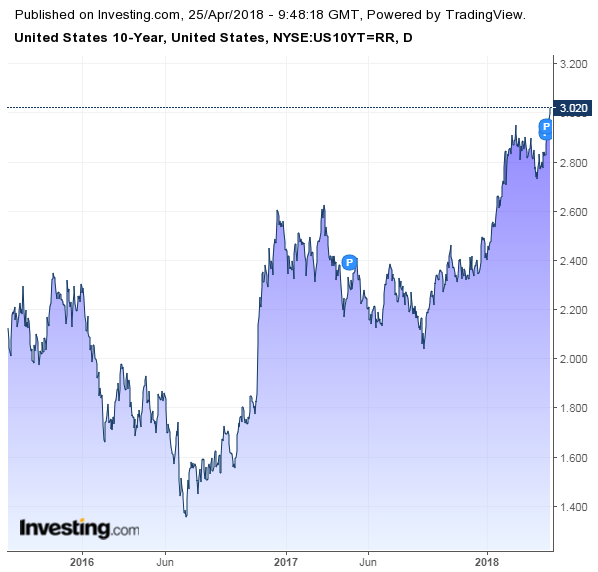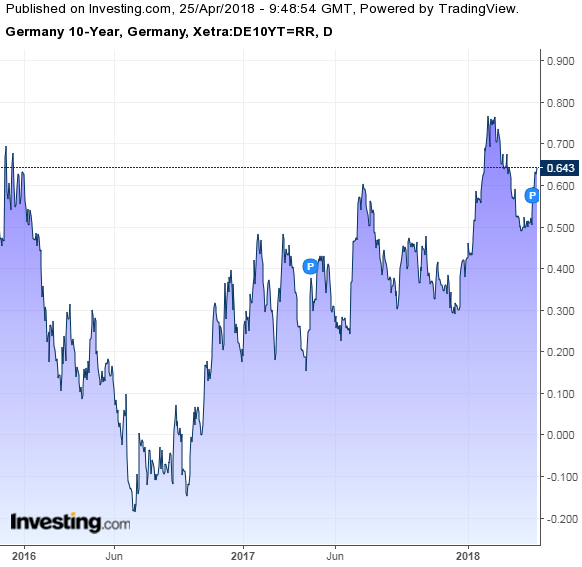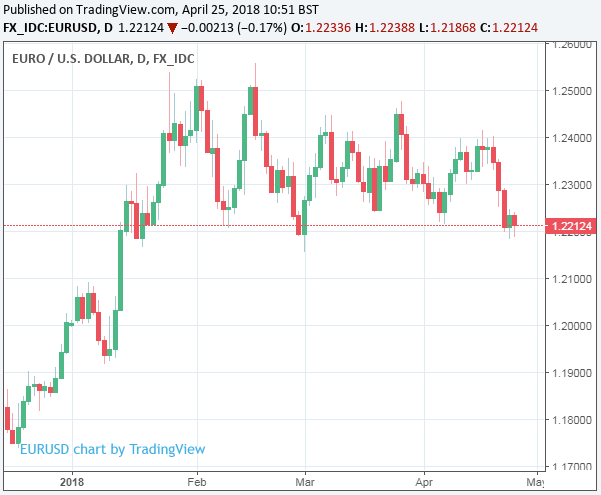EUR/USD En Route to 1.16? Analysts Warn Downturn on the Cards as U.S. Yields Top 3% and ECB Eyes Currency Strength
- Written by: James Skinner
- EUR/USD is in danger of breaking key support level at 1.2150.
- Thursday's European Central Bank meeting may prove the catalyst.
- Analysts increasingly of view the Euro's best days are behind it for now.

© Grecaud Paul, Adobe Stock
The Euro-to-Dollar rate is on the cusp of another leg downward, according to analysts, and Thursday might prove the catalyst for Europe's single currency to break below a key technical threshold.
Storm clouds have been gathering above the Euro all week given the greenback is now receiving support from an increase in US bond yields, but so far the lower bound of the exchange rate's four month range at the 1.2150 level has held firm.
Europe's single currency has spent the 2018 year bouncing between 1.2150 and 1.2550 after an earlier 12 month period where traders dumped the US Dollar and bought the Euro by the bucket load.
This had pushed the EUR/USD rate up by 17% during the year to January although, since then, the currency pair has become entrenched in the above narrow range as euphoria around the Euro waned.
"EUR/USD has recently eroded its 2017-2018 uptrend and the base of the short term triangle, this is negative price action. We suspect that in order to really generate some downside interest that we will need to see a close below the 1.2155 February low (favoured)," says Karen Jones, head of technical analysis at Commerzbank.
Above: EUR/USD rate shown at daily intervals.
Policymakers were recorded in the minutes of the latest European Central Bank meeting expressing concerns about the current strength of the Euro. They flagged the January move from 1.18 to 1.25 as a particular source of concern because it appeared to them to have been driven by speculation over monetary policy, rather than by an improvement in Eurozone economic fundamentals.
Now, with the Euro having clung to much of its 2018 gains since the latest minutes were released, Thursday's European Central Bank meeting looks almost certain to bring yet more commentary from Mario Draghi and ECB officials about the perils of a strong Euro, which may be enough to tip the EUR/USD rate over the edge. Some are confident that it will be.
"We feel very comfortable with our forecast that EUR/USD will continue to correct downwards during the course of the year. The reason behind that is mainly a stronger dollar that is now beginning to benefit from higher US interest rates," says Thu Lan Nguyen, an analyst at Commerzbank. "The very hesitant ECB actions are certainly not likely to provide significant support for the euro."

Above: EUR/USD rate shown at weekly intervals.
The Commerzbank foreign exchange team are forecasting a steady decline for the common currency throughout the rest of the year and there are grounds to think they might be right in their predictions. After all, the US Dollar has entered the current week on the front foot after belatedly drawing some support from price action in the bond market.
This is after American 10 year bond yields rose above the 3% threshold Tuesday for the first time since before the financial crisis. Markets fretting over an increase in the supply of US bonds, thanks to President Donald Trump's budget-busting tax reforms and other fiscal stimuli, and traders contemplating the possibility the Federal Reserve will step up the pace of its interes rate rises this year are seen behind the move.

Above: 10 Year US Government Bond Yield.
So far German government bond yields have kept pace with the rise of their North American counterparts, breaking out from negative territory toward the end of 2017, but with the European Central Bank now seen as likely to slow the pace at which its quantitative easing program is wound down, there is a danger that the gap between US and European yields widens again.

Above: 10 Year German Government Bond Yield.
This could have profound implications for the Euro and other "low yielding" currencies because, traditionally, international investors have tended to park their money wherever relative interest rate returns have been more favourable. In the current context, this could see investors selling Euros and buying Dollars in order to exploit the higher returns on offer in the US bond market.
"The ECB will probably terminate its asset purchasing programme before or by the end of 2018. Principally we agree with the EUR-bulls’ view that this will constitute the beginning of the end of the ECB’s ultra-expansionary monetary policy. Only that this process is going to be painfully slow," Lan Nguyen writes, in a recent briefing.
Advertisement
Get up to 5% more foreign exchange by using a specialist provider to get closer to the real market rate and avoid the gaping spreads charged by your bank when providing currency. Learn more here.
ECB Enters the Slow Lane
The ECB said in December it will continue buying €30 billion of European bonds each month until “September 2018 or beyond”, with the final stoppage subject to developments around inflation. Until December 2017 it had been buying €60 billion or more each month in an effort to stoke consumer price pressures by spurring economic activity.
Markets are now looking for the bank to "taper" its monthly bond purchases to zero between September and December but this is subject to developments around Eurozone inflation which has, of late, taken a dip lower. In order for the ECB's bond buying program to be wound down Eurozone inflation must show signs of making a sustainable return to the 2% targer, but the consumer price index slipped back to 1.3% in March, according to Eurostat data.
What's more, a continued strong Euro is likely to make this goal even more distant because a rising currency reduces inflation by making imported goods cheaper for companies and consumers to buy. Lan Nguyen and the Commerzbank team say this, and other factors, are likely to keep Eurozone inflation under pressure for the time being and that this will have implications for the Euro-to-Dollar exchange rate through the rest of the year.
"Contrary to the situation in the US, especially the development of the decisive core inflation will be far from sufficient. The inflationary measures à la Trump are missing in Europe. We therefore do not share the EUR optimism the market is associating with this step," the analyst writes. "We therefore consider it to be unlikely that the euro will be able to keep up with the dollar’s positive performance this year."
EUR/USD En Route to 1.16?
Commerzbank forecasts the Euro-to-Dollar rate will decline steadily to 1.20 by the end of June and to 1.16 before the 2018 is out. This is no longer a controversial opinion as other strategists are increasingly of the view that Europe's single currency may struggle during the months ahead.
We recommend selling EURUSD spot at 1.2378, target 1.15, stop loss 1.26," says Athanasios Vamvakidis, an FX strategist at Bank of America Merrill Lynch, in a recent note. "Data, rate differentials and our central bank calls are supportive. Market is short USD. We expect recent trade tensions to ease. We expect US profit repatriation. Quant and technicals supportive. Risks: US policy uncertainty, global move towards trade protection, recent geopolitics in Syria."
The European Central Bank will release its latest monetary policy statement at 12:45 pm London time on Thursday. It will be followed by a press conference at 13:30 pm, which will garner most of the market's attention as it provides opportunity for media to ask questions of the central bank and its President.
Advertisement
Get up to 5% more foreign exchange by using a specialist provider to get closer to the real market rate and avoid the gaping spreads charged by your bank when providing currency. Learn more here.





